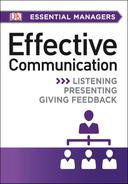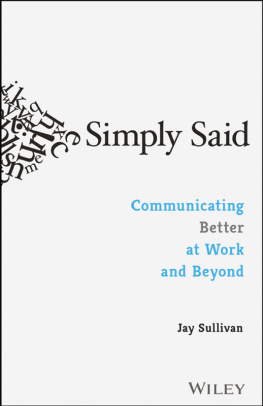Getting the Message
Getting the Message
The Wisdom of Listening
and Thinking
George A. Goens
ROWMAN & LITTLEFIELD
Lanham Boulder New York London
Published by Rowman & Littlefield
An imprint of The Rowman & Littlefield Publishing Group, Inc.
4501 Forbes Boulevard, Suite 200, Lanham, Maryland 20706
www.rowman.com
6 Tinworth Street, London, SE11 5AL, United Kingdom
Copyright 2021 by George A. Goens
All rights reserved . No part of this book may be reproduced in any form or by any electronic or mechanical means, including information storage and retrieval systems, without written permission from the publisher, except by a reviewer who may quote passages in a review.
British Library Cataloguing in Publication Information Available
Library of Congress Cataloging-in-Publication Data Available
Names: Goens, George A., author.
Title: Getting the message : the wisdom of listening and thinking / George A. Goens.
Description: Lanham : Rowman & Littlefield, 2021. | Includes bibliographical references and index. | Summary: "This book gives tips on day-to-day communication and listening"- Provided by publisher.
Identifiers: LCCN 2020042182 (print) | LCCN 2020042183 (ebook) | ISBN 9781475853841 (cloth) | ISBN 9781475853865 (ebook)
Subjects: LCSH: Listening (Philosophy) | Oral communication. | Thought and thinking.
Classification: LCC B105.L54 G64 2021 (print) | LCC B105.L54 (ebook) | DDC 302.2/242-dc23
LC record available at https://lccn.loc.gov/2020042182
LC ebook record available at https://lccn.loc.gov/2020042183
 The paper used in this publication meets the minimum requirements of American National Standard for Information SciencesPermanence of Paper for Printed Library Materials, ANSI/NISO Z39.48-1992.
The paper used in this publication meets the minimum requirements of American National Standard for Information SciencesPermanence of Paper for Printed Library Materials, ANSI/NISO Z39.48-1992.
FOR
My mother, Stephanie Goens
She taught me to take responsibility and deal with
lifes challenges. A real role model.
My father, Earl Goens
He died when I was four years old. I think of him and
miss him to this day. He was never forgotten.
For my uncles, Zig, Bill, and Ed
They each shared a part of themselves with me that is a
part of my life to this day. Thank you.
Contents
A hawk sat on the birdfeeder at the edge of the open field by the deck. My seven-year-old grandson Eddie was watching, and then the Hawk let out a loud piercing screech, chwirk. He was fascinated. He asked if birds talk to each other. I said, Yes, they do.
But how do they hear? They dont have ears.
They do, you just dont see them, I replied.
Birds do not have external ear structures, but they do have ear openings beneath their feathers on the sides of their heads. The feathers cover the ear openings to protect them from wind and noise. The communication of birds involves mating calls, defending their territory, finding food, and directing their offspring.
Most animals have means to communicate. Like people, they have different styles of connecting. Most everyone knows that birds sing: some to mark territory and others to raise alarm. Some birds also communicate through their behaviorstrutting and dancing to attract other birds. They have needs as other living things do, and they communicate through singing, calls, warbles, and screeches.
I followed up our conversation with, You know, the question is not whether birds or others can hear, its whether they really listen! Theres a big difference between hearing sound and listening. He gave me a quizzical look.
Human beings have more complex means of communicating: certainly voice, but also physical actions, and also writing, drawing, and other means of expressing feelings and perspectives. While people are unique, they each have similar needs and desires. Any distinction on the basis of heritage, race, gender, or culture does not diminish the essential physiological or emotional needs all people have concerning speaking, being heard and listening. Being heard goes much deeper than simply hearing ones words. Proper and respectful attention is necessary because people really want to be understood, and words and actions are open to many interpretations.
They obviously engage verbally as evidenced in all kinds of formal or informal situations: caring, loving, directing, instructing, and others. All individuals at one time or another participated in these conversations.
Discussions involve more than verbal exchanges. In these interactions, the parties talk but also communicate nonverbally through physical and facial demeanor and mannerisms, as well as through tone of voice. Verbal and nonverbal expressions should be congruent with the purpose of the presentation, rather than providing mixed messages. But that is not always the case.
Not only is physical action involved in talking and listening, but also there are deeper emotional and intangible issues concerning feelings and relationships. Listening is about sharing oneself through understanding the context and intent of a persons message. Listeners are simply considerate individuals who want to discern another persons thoughts, feelings, experiences, and circumstances.
Communicationtalking and listeningtakes place at the moment, face-to-face or through online technology. Written notes and letters have a missing link, the physical and immediate presence of the individual, which makes discussions more personal, immediate, and open to greater dialogue. Conversation is distinctive between different people because of the nature of their relationship: formal or informal, family or social, and business or emotional.
Professional discussions generally are more formal in tone and language, in part because of specialized content and organizational decorum. Formality and informality affect discussion, as well as the emotional or cognitive tenor of it. However, the basic quality is to be respectful no matter what the context or content.
Certainly, children have to learn about discussions and how to engage in them. Listening for children is not an easy skill to learn. Actually, it is not simple for some adults either. They get excited, interrupt, and speak loudly or they emotionally shut down. They can be defensive and desire to be good. Often parents say, Just listen to me when having a conversation about behavior as a child tries to justify their conduct or avoid the potential repercussions.
As Abraham Maslow stated: To be able to listenreally, wholly passively, self-effacingly listenwithout presupposing, classifying, improving, controverting, evaluating, approving or disapproving, without dueling with what is being said, without rehearsing the rebuttal in advance, without free-associating to portions of what is being said so that succeeding portions are not heard at allsuch listening is rare.
Communication is essential in all facets of life because it concerns not only the physical process of talking and listening but also emotional and psychological concerns and ethics. The nature of the conversation also brings expectations and opens or closes doors to further communication.
Note
Abraham Maslow, The Psychology of Science (New York: Harper and Row, 1996), 96.
The sides are being divided now. Its very obvious. So if youre on the other side of the fence, youre suddenly anti-American. Its breeding fear of being on the wrong side. Democracy is a very fragile thing. You have to take care of democracy. As soon as you stop being responsible to it and allow it to turn into scare tactics, its no longer democracy, is it? Its something else. It may be an inch away from totalitarianism .











 The paper used in this publication meets the minimum requirements of American National Standard for Information SciencesPermanence of Paper for Printed Library Materials, ANSI/NISO Z39.48-1992.
The paper used in this publication meets the minimum requirements of American National Standard for Information SciencesPermanence of Paper for Printed Library Materials, ANSI/NISO Z39.48-1992.